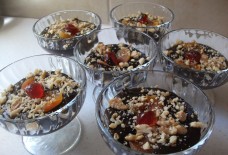The History of the Decorative Patterns on Maamoul
BY: Sara Alsayed / Arab America Contributing Writer
Maamoul is a traditional dessert that is common among Muslims during the month of Ramadan and Christians during the month of Easter. Maamoul is a type of cookie that is served to guests and all people. Commonly, you will find Maamoul displayed on the table quite beautifully or see people handing it out to celebrate the months of Ramadan and Easter.
Maamoul has a significantly unique shape that allows others to immediately identify it, as Maamoul. It is small and round, it is most often decorated with carvings, and you will probably find it covered with powdered sugar.
However, have you ever stopped and wondered what those decorations mean? And where did they come from?
According to Ahmed Amer, a historian and an archaeologist, the Eid Al-Fitr cookies could date back to the Fatimid rule. “During the Fatimid age, Egyptians would give out candies to state officials, organize huge banquets. Caliph al-Aziz Bellah would erect two banquets on the occasion of Eid al-Fitr.”
Maamoul was handed out to courtiers, officials, guardsmen, and servants in the great hall of the palace. And with the rise in popularity of the Maamoul, there were times when the palace kitchen could no longer handle the large number of people coming to the palace. So, the Caliph al-ʿAzīz, in full Al-ʿazīz Biʾllāh Nizār Abū Manṣūr decided to establish a place dedicated to the production of sweet pastries.
On the first day of Eid, the people would march to Bab El-Nasir (literal meaning: Gate of Victory). Afterward, they would pray the morning prayer (Fajr), and the statemen would distribute the Mamoul to the people.
The cookies were decorated with phrases such as (Kol wa oshkor), which means to eat and be thankful. As well as (bel shokr tadoom al neam), which means gratitude preserves blessings.
Now, you may say, well, the Maamoul we have today does not have these phrases or words. Well, to understand the new patterns, we must go further back.
The art of making cookies and bread come from the same source of reason to nourish but also for expressing beliefs, myths, and even taboos. The history of bread as we know it, began 14,000 years ago when human’s evolution had begun to take a turn toward progression. We had left our nomadic ways of life and had begun farming and growing cereals. However, the place of origin of the discovery of wheat was in Egypt, where it was considered the sign of life and fertility.
Different types of bread were baked and carved with different decorations or carvings. It is well documented that cookies and bread were decorated with the form of animals, flowers, suns, etc., as offerings to the gods and for the cult of the dead. We know this from drawings on the walls of the pyramids, which depict the process of making bread and cookies, even portraying many of the special designs used to decorate them.
The Decorative molds originated in ancient times in Egypt. However, it began with the molding of architecture and buildings before they were used for imprinting bread and dough. In addition, decorative molds were also used to imprint clay and coins as they depicted a variety of subject matter, including historical events, religious symbols, romantic motifs, portraits, and even proverbs.
If you look closely at your Maamoul molds, you will find that they resemble sunbursts similar to the picture shown above. This is a sign that maybe the molds were handed down from an ancient culture that worshiped the sun. Some patterns resemble the pattern of raindrops when they hit the soil or water. According to historians, they believe that it was to celebrate the rain and a good season for the farmers.
Maamoul decorations and carvings have a long history; however, it is still a beautiful addition to Mammouls that each and every one of us should be adding to their dessert.
Check out Arab America’s blog here!








